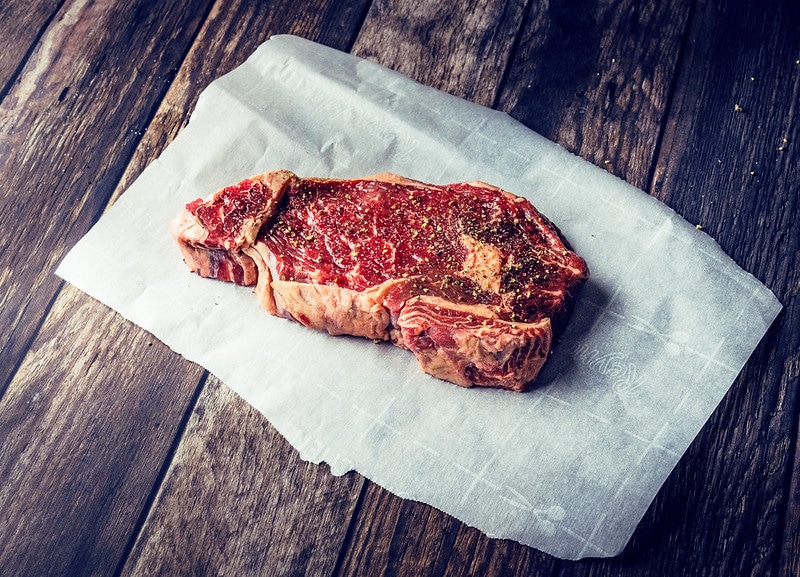Once deemed a futuristic alternative, lab-grown meat is starting to become a reality following the recent news that the Singapore Food Agency approved lab-grown ‘chicken bites’ for sale from Eat Just. Lab-grown meat products (also known as in-vitro meat, cultured meat, cellular agriculture, or clean meat) are being created by dozens of firms worldwide to downsize and streamline traditional agricultural practices to lessen the environmental impacts and animal welfare issues associated with farming, among other problems. However, there are several barriers that need to be addressed for lab-grown meat to become a successful ethical and sustainable alternative to traditionally farmed products.
—
Lab-Grown Meat: Global Statistics
Annually, between 11.8% and 14.5% of all global greenhouse gases are emitted by the agricultural sector. The impact from these GHGs exceed other sectors that emit similar percentages of emissions: methane (CH4) and nitrous oxide (N2O) make up the majority of GHG emissions from livestock and farming practices, which are respectively 21 times and 300 times more dangerous than carbon dioxide (CO2) due to how these gases absorb solar radiation, how long they reside in the atmosphere, and their ability to deplete the ozone layer. Food production is the largest stress on biodiversity, with half of the world’s habitable land (51 million km2) currently covered by productive agricultural land.
From 1965 to 2015 there was an increase in the global average meat consumption per capita, from 24.2kg to 41.3kg. Despite this increase of global meat production, which peaked at 340 million tons in 2018, the Food and Agriculture Organization (FAO) and UN estimate that global meat production declined in 2019 and 2020. As this decline was partly forced by the COVID-19 pandemic in 2020, 2021 is expected to see similar declines in meat supply and demand.
However, some countries are still seeing a major uptick in meat consumption. Most notably is China: following the reforms and opening-up of the nation under Deng Xiaoping in the 1970s, individual meat consumption has risen from less than 5kg per year in the 1960s, to 63kg today. China now consumes 28% of the world’s meat products, which includes 50% of all pork produce (China is also the leading producer of pork). Other countries with fast growing middle-income classes such as Brazil and Nigeria are also seeing rapid increases in their meat consumption. And, with the global population set to increase to 9.7 billion people by 2050, current rates of food production are expected to increase by an estimated 70% within the same timeframe.
Lab-Grown Meat: Benefits and Barriers
A 2018 study in Science states that reducing meat consumption is the best way for an individual to reduce their carbon footprint and lessen the environmental and ecological impacts of livestock farming. While there is often a good range of plant-based alternatives to meat products available in many countries, the high demand for meat around the world necessitates the need for meat alternatives such as lab-grown meat that can mitigate agricultural-related environmental impacts and GHG emissions, while fulfilling the world’s demand for meat produce. A widely cited 2011 paper on the lifecycle assessment of lab-grown meat suggests that in comparison to conventional European-produced beef, lab-grown meat production emits 96% less GHGs, uses 99% less land, and consumes 45% less energy. Additionally, humanity’s relationship with animals and the consumption of conventional animal produce will need to change to reduce the frequency and prevalence of zoonotic diseases that have disastrous effects on global society, as seen with the current COVID-19 pandemic.
The process of creating lab-grown meat means that natural animal produce could almost be entirely removed from the food system in a ‘post-animal bioeconomy’. Lab-grown meat is created by extracting and growing stem cells on a biodegradable cell scaffold in culturing media to encourage muscle growth. Pieces of ‘meat’ are then cultivated from the solution and put together with fats and colouring to produce a consumable piece of ‘meat’ that typically resembles a beef steak, chicken breast or piece of shrimp.
A major strength of lab-grown meat is the improvements in animal welfare. By removing animals from the food production process, the need for intensive agricultural practices, battery farms and abattoirs is eliminated and takes animal suffering out of the equation. Globally, it is estimated that more than 70 billion land animals and 90 billion marine animals are killed annually for human consumption. By taking animals out of the food production process, issues related to animal welfare such as the mistreatment of animals, poor living conditions and disease outbreaks could start to be eliminated.
The current process for lab-grown meat production involves the use of foetal bovine serum (FBS). FBS is produced from blood extracted from calf foetuses or pregnant deceased cows, so the narrative that lab-grown meat does not use any animal products or byproducts to be created is currently false. Current technologies require a large number of animal cells and FBS, necessitating the death of animals. On a positive note, ongoing research by Newcastle University and CPI is seeking to develop a non-animal growth media to create a truly animal-free ‘meat’ product.
In the future, lab-grown meat could become an accessible and cheap protein source, and could be used to address food security issues and food shortages that have been recently exacerbated by the COVID-19 pandemic, where access to meat is often noted as a specific cause of food inequality. A barrier to lab-grown meat being a successful and accessible product is its price. In 2013, the first lab-grown ‘beef burger’ cost over US$300 000. This price has reduced immensely, but it is still costly: lab-grown ‘ground beef’ from Memphis Meats costs around $2 400.00 per 450 grams, whereas conventional ground beef in the United States costs around $17.75 for the same amount. However, progressions in meat culturing technologies and the potential for upscaling production with increasing demand could mean that in a few years lab-grown meat products could enter the global market at a much more affordable price and as an economically viable alternative to conventional meat.
As noted, lab-grown meat has only recently been approved in Singapore for sale – the first country to do so. New food products that enter the market need to maintain standards and require stringent regulations. Outside of Singapore, present regulatory frameworks over livestock and meat production do not take lab-grown meat into account. Due to the nature of lab-grown meat and how it is made, trade associations and food regulating bodies are apprehensive as to how this can be achieved, especially on a global scale. And, as with genetically modified crops (GMOs), enabling the unrestricted global trade of lab-grown meat products could be challenging, depending on how various countries and trade blocs regulate and authorise the production and sale of lab-grown meat. This could be resolved with an international regulating body to oversee global standards of lab-grown meat in order to allow more equitable and fair access to these products.
With continued high demand for meat, increasing numbers of middle-class consumers, and a rising global population, the need for a viable and sustainable meat alternative has never been greater. Lab-grown meat technologies offer an exceptional chance for the global agricultural industry to decarbonise while still providing an accessible, sustainable and ethical product. However, given its relatively new conception, there are a number of barriers that need to be overcome. Namely, the cost, regulation and governance of the product and the conditions under which it is made must be considered for it to be a successful alternative to conventional meat.
Featured image by: Flickr
You might also like: Lab-Grown Leather: A Sustainable Solution to the Fashion Industry?














